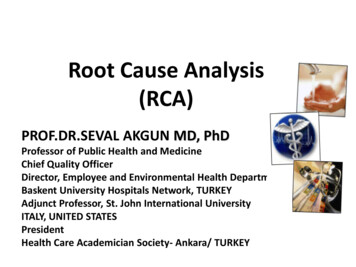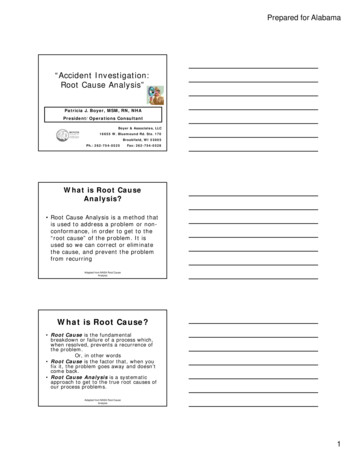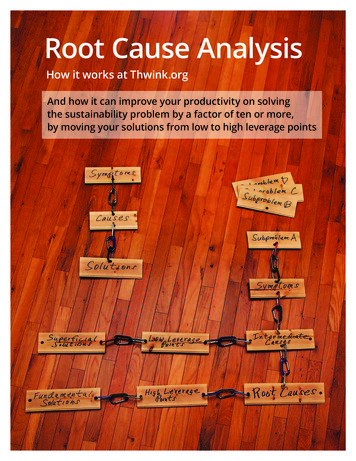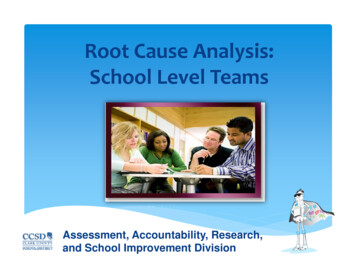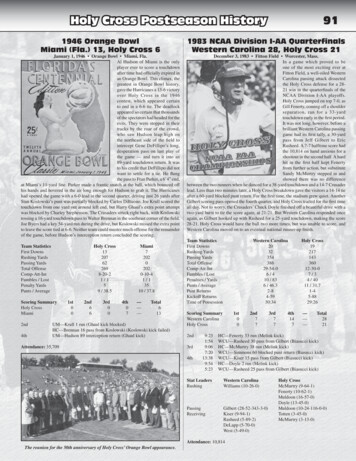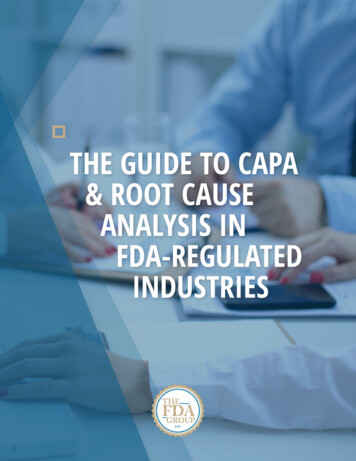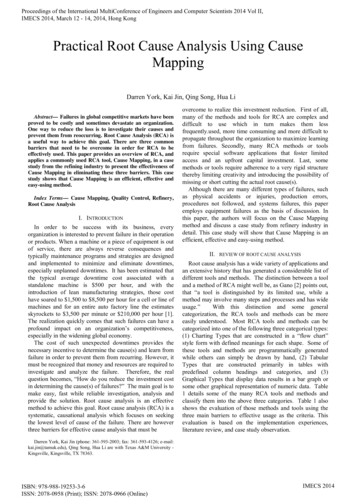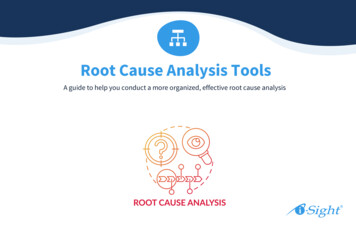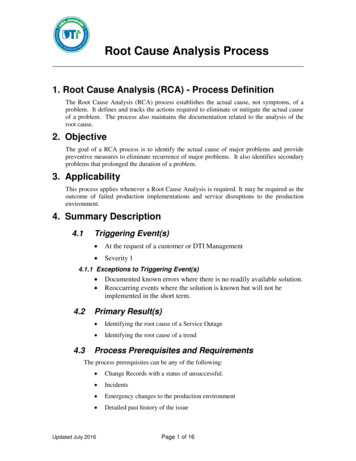
Transcription
SArts andJournalesial SciencocArts and Social Sciences JournalISSN: 2151-6200Mohammed, Arts Social Sci J 2016, 7:2DOI: 10.4172/2151-6200.1000188Research ArticleOpen AccessCause and Consequence of Cross Border Illegal Migration from SouthWollo, EthiopiaMohammed YA*Department of Social Sciences, Wolaita Sodo University, Sodo, Ethiopia*Correspondingauthor: Mohammed YA, Department of Social Sciences, Wolaita Sodo University, Sodo, Ethiopia, Tel: 920275116; E-mail: yimer.ali9@gmail.comReceived date: April 19, 2016; Accepted date: May 25, 2016; Published date: May 31, 2016Copyright: 2016 Mohammed YA. This is an open-access article distributed under the terms of the Creative Commons Attribution License, which permits unrestricteduse, distribution, and reproduction in any medium, provided the original author and source are credited.AbstractDeveloping countries such as Ethiopia the phenomenon of cross border Illegal migration which is mainly triggeredby rural 'push' causes than urban 'pull' causes is the main cause of unbalanced rate of population growth anddistribution between urban and rural areas in origin and destination states. This situation in turn affects the healthydevelopment of both urban and rural areas. In spite of this fact, not much in known on many of the recent aspects ofillegal migration. The present study of migration from Kutaber is mainly concerned with an assessment of the majorcauses and consequences of cross border illegal migration of people from rural- urban areas to foreign countriesmainly to Gulf States. To achieve the objective 120 household heads were selected randomly from three kebeles ofthe woreda to Schedule interview. Both primary and secondary data were employed and were analyzedquantitatively and qualitatively. Key informant interview and focus group discussions were prepared to generateinformation about the cause and consequences of illegal migration from Kutaber Woreda.Some of the causes of illegal migration are: land fragmentation, poverty, drought, need to join friends andrelatives, income generation, the search for job and urban amenities, un coordinated activity of legal emigrationprocess, and facilities in desired state are the most important. The study shown that the large family size and smallland holding exposed to cross border illegal migration. Many of the migrants encountered problems at the initialperiod of adjustment and adaptation and even while traveling in night forest and coastal areas. While negative sideof illegal migration is moral deterioration, Dept crisis, work load on migrant and remaining family, rejection by theirfamilies, and the community as they failed to meet expectations to return with adequate material wealth.Keywords: Migration; Cause; Consequence; Origin; DestinationIntroductionThe movement of human populations across the planet hascharacterized human societies throughout history. Together with birth(fertility), death (mortality), migration forms a third fundamentalelement in determining population growth and structure. Migration isusually defined as the movement of person or group of persons fromone geographical unit to another country across an administrative orpolitical border, wishing to settle permanently or temporarily in a placeother than the place of origin [1]. Historically, resource scarcity ordepletion has induced this movement to migrate. In recent years illegalmigration has endangered Ethiopian people’s livelihood and the imageof country. Because of the clandestine mode of middle men and fewindividual, many problems have happened in different parts of thecountry. This illegal migration is pursued the young generation it as agood chance to them rather than going through the legal one. But thetruth is there the legal means give guarantee for those individuals whohave migrated abroad. The issue recently has gone from bad to worse.Even here in the initial phase of transportation and to the desireddestination, many migrants in our case study area (who are bothfemales and males) have faced the challenges and difficulties. The riskand damage is catastrophic for women especially. Like other parts ofthe country, movement of people across regional and zonal boundariesis historically a common phenomenon. In this case, the influx ofemigrant people to small and big towns and countries is due toeconomic and other non-economic reasons.Arts Social Sci JISSN:2151-6200 ASSJ an open access journalOne can identify several causes for the movement of the people inparticular from Kutaber woreda and from the Amhara region ingeneral. The motivation for such illegal emigration as stated byInternational Organization for Migration is the need to join friendsand relatives, the search for job and urban amenities and betterfacilities. Besides to the migration from rural to urban areas, thepeople have migrated to other countries both legally and illegally. Mostproblems have happened because of the illegal migration caused withthe unholy alliance of illegal Individuals and groups. The state ofmigration widely varies with both short term and long termimplications. But most studies indicate the economic motives as themajor driving force behind the recent spate of migration phenomenonfrom Ethiopia. In addition, the relative improvement of differentfacilities and better living conditions in the areas compared to theliving areas is the main pull factor.Studies like the IOM-World Migration Report [2] have indicatedthat chronic lack of rural and urban employment opportunities, rapidincrease in population pressure, absence of oxen for many farmers andland fragmentation have been the major forces behind the highmigration from Ethiopia. This external migration of the mostproductive section of the communities that are mostly young bettereducated and informed which leads to a severe consequence in therural-urban livelihood and image of country. Even if few migrants gainbetter living standard and income by this migration, many of themigrants have encountered problems at the initial period ofadjustment and adaptation and even during transportation. All thesefactors have motivated the researcher to undertake this study. RecentlyVolume 7 Issue 2 1000188
Citation:Mohammed YA (2016) Cause and Consequence of Cross Border Illegal Migration from South Wollo, Ethiopia. Arts Social Sci J 7: 188.doi:10.4172/2151-6200.1000188Page 2 of 20the researcher has noticed several such happening or events fromdifferent Medias (TV, Radio, newspapers and journals) on the plight ofEthiopian migrants to the gulf region. However, many of them are farbelow the living standards of the people from the host countries.Another consequence that arises in situations of migration is racismand the unequal treatment of migrants. This is often portrayed as aconsequence of migration but is a product not of the process ofmigration but as the treatment of migrant by host countries. Whilethere is consensus on the benefits of an open trade regime and arelatively liberal capital movement, that consensus rarely extends tofree movement of people across countries.In Ethiopia particularly a very few studies have been undertakenand there is a lack of adequate understanding of the process of illegalmigration and its causes and consequences on the migrants andfamilies. It has also spoiled the image of country. The main purpose ofthe present study is to provide some analysis for policy makers,administrators, and academic institutions and to the concerned peoplein the woreda and Ethiopia. Indeed the purpose of this study is toinvestigate the flow pattern and the characteristics of migrants, causesand consequences of the out ward illegal migration by taking Kutaberas a case study. Kutaber is one of the Woreda towns in, South Wollo,Amhara Regional state, Ethiopia that has been experiencing rapidillegal migration to different gulf countries both legally and illegally.But for this study I would especially focus on the cause of illegalmigration with its pleasant and unpleasant consequences on KutaberWoreda.Statement of the problemHuman beings primarily move to different areas for several reasons.Historical evidences have pointed out that people were forced to movedue to war, trade, pilgrimages, drought and famine, developmentprograms, land tenure system, and because of natural and manmadecalamities. The destruction of the environment has influenced outmigration decisions either through decreased food production orthrough decline of an area’s desirability or attractiveness as a residence.In 2005 Ethiopia had an emigration rate of 0.6 percent, which is lowin comparison to Africa as a whole. In Ethiopia, massive movement ofpeople from place to place has been caused by both natural and manmade disasters. Earlier researches have highlighted that landlessness,agricultural policy, land fragmentation, environmental degradation,population pressure, recurrent drought and famine, war and politicalcrises were the major factors responsible for spatial mobility [3].Keeping in mind the pros and cons of migratory movement of peoplewithin and outside the countries territory, it is important to note thatthe cause of illegal migration should be identified. In the era ofglobalization, an improved and sophisticated means of transportationand communication are playing a key role in facilitating the interactionof people around the world. As a result, the rate of migration isalarmingly increasing both at national and international level legallyand illegally. In developing countries, like Ethiopia the recent increasein illegal migration is more persistent.This study aims at examining the overall process of illegal migration(i.e., the causes, and consequence) in selected administrative zones ofSouthern Wollo, Amhara Regional State namely Kutaber woreda. Inthis woreda the problem is complicated due to the socio economic andpolitical development. Recently many people from woreda have beenmigrated legally and illegally. The legal means of migration to the Gulfand other countries to some extent is better than that of the illegal onein improving income generation and livelihood of the people. BecauseArts Social Sci JISSN:2151-6200 ASSJ an open access journalthis has been conducted through the agreement of labor and socialaffairs in between two countries. Therefore when the agreement issigned, it gives guarantee in time of emergency for labors that migratefrom Ethiopian kebeles. Whereas the illegal migration, beginning frominitial period of preparation to the process and end lacks such contractagreement. But some illegal migrant succeed in getting better income.However there is a gap in between legal and illegal migration by itscause and consequence up on the Kutaber Woredas people livelihood.In Kutaber woreda, one can’t get sufficient studies on thecharacteristics of migrants, the patterns, causes and consequences ofillegal migration. The purpose of this study is, therefore, to investigatethe flow pattern and the characteristics of migrants, the causes andconsequences of out ward illegal migration by taking Kutaber as a casestudy. The study mainly emphasized on migrants’ who are gone toMiddle East. Kutaber is one of the woreda (district) in the Amhararegional state that has been experiencing rapid population growth,thus motivating a large proportion of people to migrate. It is hopedthat this study will contribute to the body of limited and insufficientliterature on illegal migration from Kutaber Woreda and in countylevel generally. It would provide some analysis on the efforts of ruralurban management, the formulation and implementation of rural andurban development policies and programs of the woreda.General ObjectivesThe major objective of this study is to examine the causes (as to whypeople migrate), and consequence of illegal migration from Kutaberworeda, Southern Wollo, Amhara Region.Specific objectives The specific objective of the study includes:To investigate the underlying economic and non-economic causesfor illegal migration.To identify the major differentials and determinants of illegalmigration from woreda.To explore the positive and negative consequences of illegalmigration on migrants’ and their families in the study area.To assess the effects of illegal migration with emphasis on thegender dimension.Review of Related LiteratureConcepts and definition of migrationMigration is a multidimensional phenomenon and deals witheconomic, social and political factors. Basically, it involves localities,which are areas of origin and destination involving either change inresidence for short or long periods of time. It is very difficult to definein comprehensive explanatory and analytical framework with regard tomigratory processes. It was estimated that by 2010, 10.2 percent ofglobal migrants will hail from Africa [4]. Only three percent of thepeople from different parts of the world migrate, and around 1.9percent of Africa’s populations engage in international migration [4].Recently, there has been a large influx of Ethiopian migrant to theAfrican and Middle East, serving primarily as domestic laborers inprivate households. This migration and employment in a foreigncountry has the potential to bring negative and positive prospects forthese peoples. Simultaneously, there is also a great risk of exploitationand abuse associated with such migration.Volume 7 Issue 2 1000188
Citation:Mohammed YA (2016) Cause and Consequence of Cross Border Illegal Migration from South Wollo, Ethiopia. Arts Social Sci J 7: 188.doi:10.4172/2151-6200.1000188Page 3 of 20Aina [5] elaborates that migration could literally be taken as thephysical movement of people from one geographical area to another bychanging residence usually not for less than a year. Migration isdifficult to define and measure which involves in a physical transactionwithin special form of spatial or geographic mobility of humanpopulation dealing in movement, a change of residence, a change inthe physical and social environment, distance and time. There is nodefinite criterion or definition as to what constitutes any one of theabove elements, especially time and distance. Regardless of thedifficulties involved, however, the term migration connotes a form ofpopulation movement that takes place when a person changes his/herplace of residence either temporarily or permanent basis, though thelength of time and distance to be covered is determined ratherarbitrarily, and depends on the purpose of the classification and set ofcriteria used.In broader terms migration can be divided into two broad groupsinternational migration and internal migration. Internationalmigration involves the movement of people across political boundariesto a different country than an area of origin whereas internal migrationis the movement of people within the national boundary of a specifiedcountry. Internal migration is by far the most important factorresponsible for major demographic changes in Africa. Based on thedirection of movement internal migration can be further divided intorural-rural, rural-urban, urban-rural and urban-urban. In additionmigration can be legal/regular or illegal/irregular. It is useful todifferentiate migrants on the basis of the (intended) length of theirstay, as follows.Long-term migration-Examples of people in this category include: Labor migrants (these can be either high-skilled or low-skilledworkers who seek permanent employment elsewhere).Professional, business or investor migrants (e.g., individuals inspecific professions, or those who invest or establish businesses in areceiving country).Forced migrants (e.g., political or religious refugees and asylumseekers).Temporary Migration-Examples of people in this category include: Labor migrants (e.g., seasonal migrants, laborers on temporaryworking visas, or commuter migrants).Professional and business migrants (e.g., diplomats and otherbusiness migrants, religious migrants).Student and scholar migrants (e.g., degree-seeking students, shortterm students, and exchange scholars) [6].They are of many types and include movements of nomads as wellas those of agriculturalists and other peoples and traders. Thesemovements can be seasonal, long term or permanent based on thepurpose of migration. In many cases, migration is not just a once or allmove. Rather there are series of moves over a lifetime. The movementof people can be broadly defined as temporary, semi-permanent orpermanent change of location. From the definition, no restriction ismade on the distance to move or its duration and no distinction ismade between movements within a country and among countries.On the other hand, migrants may enter countries illegally using thehelp of smugglers. Smugglers act as extra-legal travel agents-hidingpeople in trucks for example, or supplying false passports, or bribingimmigration officials. This is a dangerous, but usually very profitable,business. Trafficking is also another way which is somehow related butdifferent from smuggling, though there is often some overlap and theArts Social Sci JISSN:2151-6200 ASSJ an open access journalperpetrators may be the same people. An important issue that comesup in the process of migration is the issue of assimilation, adaptationand acculturation of migrants in their destination areas. Migrantworkers are usually engaged in unskilled works which are not preferredby the native workers of the host country. Similarly, those who are notrecognized legally by the government of the host country take upsecondary jobs not taken by most native workers. Another issue to beraised in the assimilation process is the interaction between migrantsand the native people. To understand this relationship, it is importantto identify the way immigrants are treated by the host society and thegovernment. Migrants assimilate to the value structure of the newsocieties at a different degree. Usually this difference is attributed tothe difference in perception to the desirability of the new culture andvalues.Migrants are defined as those who have moved at least once in theirlifetime from a given geographical region or from the place in whichthey were born to any other part of the country, in order to make aliving for a substantial period of time. Analysis of migration patternsbased on 1984 Census data indicates substantial regional variation innet loss or gain of population through migration. The regions that hadexperienced a net loss through migration in the years before the 1984Census were Wello followed by Tigeray and Gonder. These constitutethe northern provinces of Ethiopia.Africa union agreed on Joint Africa-Eu Declaration on Migrationand Development to finding concrete solutions to the problems posedby illegal or irregular migratory flows by regulating the influxes ofmigrants from Africa within the context of genuine partnership thatensures the eradication of poverty, unemployment and diseases therebyachieving comprehensive and sustainable development. Ethiopia is acountry of origin, transit and destination for international migration.While outward migration from Ethiopia includes voluntary,involuntary and forced migration, inward migration largely consists ofrefugees. Centrally located in the Horn of Africa, Ethiopia hasdeveloped into a major transit point or “migration hub” along theEastern African migration routes both for transit migration andirregular migration movements. The process of migration from, AddisAbaba is said to be a hub on two land routes of which one leads fromthe Horn of Africa via Sudan, Chad and Libya to the MediterraneanSea and the other through Somalia to Yemen across the Gulf of Aden.Ethiopia’s Bole International Airport is also reported to be a hub oftransit and irregular migration on the air route leading to Europe,including irregular migration flows from Asia transiting throughAfrica.Theoretical ReviewThe human capital (neo-classical) theoryFor the human capital theory, migration occurs as a result ofindividuals’ attempt to maximize their life time income by relocating toa new place. In doing so, they make a cost benefit analysis and decideto migrate if their expected discounted net-benefit from migration ispositive. More specifically, they compare the net-benefit from higherwage at the destination with the associated cost of relocation. As such,migration is considered as an investment to get higher income in thefuture [7,8]. The Harris-Todaro model [9,10] is an example of thehuman capital model where difference in expected earnings betweenurban and rural areas is the driving force for migration.Volume 7 Issue 2 1000188
Citation:Mohammed YA (2016) Cause and Consequence of Cross Border Illegal Migration from South Wollo, Ethiopia. Arts Social Sci J 7: 188.doi:10.4172/2151-6200.1000188Page 4 of 20Differences in individual characteristics lead to differences inexpected benefit and cost of migration. Hence, migration could bebeneficial for some and not for others. It is believed that those who areyounger, more educated, singles, and males are more likely to migrateas they are expected to extract the highest benefit from migrationand/or their cost of migration is supposed to be lower [11,12]. Despitethe fact that the human capital theory has been very popular, it is nowwell accepted that it has serious limitations. It abstracts from otherimportant factors of migration other than wage difference andimplicitly assumes that markets, most notably credit and insurancemarkets are perfect. Furthermore, like any neo-classical model itassumes that the decision to migrate is made at individual level with norole given to the family [13].The New Economics of Labor Migration (NELM)The NELM is developed to overcome the weaknesses of the humancapital model mentioned above. It shifts the decision unit from theindividual to the family. It is the family who decides whether anindividual should migrate or not in such a way that the familyobjective function is maximized. Not only does the NELM change theunit of analysis from the individual to the household, it also bringsabout new motives for migration other than maximizing income.Among other things, households want to minimize risk by diversifyingtheir source of income. To this end, they send some member of thehousehold to another place where income is not correlated ornegatively correlated with income at the origin. Hence, the migrantmember will support the family during bad times (like crop failure)while the family covers her migration cost and also supports herduring bad economic conditions at the destination [14-16]. The NELMalso puts the issue of migration in a broader context and posits thathouseholds care about their relative position (deprivation) in theircommunity. i.e., they send members to another place to improve theirrelative position in the community [17-20]. Though the NELM modelhas many noble contributions for the understanding of migration it isalso criticized for totally ignoring the role of individuals in themigration process. While the situation of the household might affectthe likelihood of individuals’ migration, it is also worth noting that theindividual can have an important role in the decision to migrate [21].The social capital (Network) theoryFor the social capital theory migration is caused by social networksbetween the place of origin and the destination. Migration networksare considered as a social capital where members of the network havethe right to get information and other supports that makes migrationmore beneficial by increasing the gains and lowering the costs. Friendsand relatives at destination serve as sources of information about theopportunities, risks and challenges associated with migration. Theyalso help new migrants to settle in easily by offering housing and othersupports. Furthermore, the presence of friends or relatives atdestination makes the psychic cost of moving to a new place lower.Thus, migration becomes more attractive for individual with networksat destination. Networks could also be at a higher level like community.Individuals from communities that are strongly connected with thedestination have easy access to information and will get support afterthey migrated [22-24].Networks at different level are important for any type of migrationand more so when more uncertainties and difficulties are involved.Thus, the importance of networks is higher for cross-border migrationthan for migration within one country like rural-urban migration.Arts Social Sci JISSN:2151-6200 ASSJ an open access journalEven for international migration, social network is more important ifmigration is illegal and involves higher risk.Causes of illegal migrationCentral to the understanding of illegal migration flow is thetraditional push-pull causes. “Push factor” refers to circumstances athome that repel; examples include famine, drought, low agriculturalproductivity, unemployment etc. while “pull factor refers to thoseconditions found elsewhere (abroad) that attract migrants. There aremany factors that cause the dependent variable (illegal migration)which are independent variables including push- pull factors.Most analyses of attitudes towards international migration andmigrants have focused on the destination end of the process and, thus,upon immigration. However, migration also has profound impacts onsending countries and their populations. Emigration has become anissue of increasing significance, not only because of its increasing scalebut also because of the increasing evidence of its impact ondevelopment in recent years.The causes of illegal migration differ from individual to individualand from community to community. If someone asks, why peoplemigrate out of their origin in favor of places that are not familiar? Thereasons will vary with causes found in such diverse factors asecological pressure, economic incentives, psychological motivation,politics situations etc. Africa has extremely accelerating populationgrowth which influences both for internal and external migration dueto the population pressure in connection to this Hance [25] identifiedareas suffering from population pressure and some indicators are :poverty, soil deterioration, degradation or outright destruction, Use ofexcessively steep slopes and other marginal lands, Declining cropyields, Changing crop emphases, Breakdown of the indigenousfarming system, Food shortages, hunger, and malnutrition, Landfragmentation, disputes over land, landlessness, bad traditionalcultures. Rural indebtedness/inability to return debt in time of climatechange.Household decision-making is mostly common for predicting illegalmigration in less developed societies because they expect short-termmigration, circulation and the common practice of remitting incomehome. Awareness of different ways in which migration and the flow ofremittances bring or fail to achieve benefits of development programsand can provide a new perspective on development difficulties and leadto new direction options. Social, economic and non-economic causesare many and varied within countries that include defeat in war, adesire for material gain or food, the search for political or religiousfreedom etc. Migration takes place when the benefits of migration areassessed by the migrants’ interims of comparative advantages.The other basic reason for migration is that urban areas indestination area are relatively confers of power and privilege. Hence,people migrate from their home land areas for the demand of betternecessities and due to the attractiveness of facilities and concentrationof resources in the cities. These facilities and resources pull themigrants to abandon the countryside for the towns legally and illegally.The main notion of pull and push factor studies refer the causes ofmigration in relation to economic imbalance.One can take into account the inefficiencies of markets in manydeveloping settings, eventually placed the push-pull factor. Rather thanproducing adjustment and equilibrium, migration has spurred thegrowth of the informal sector as rural origin persons settled, at leasttemporarily, for wages and employment chances below the hoped forVolume 7 Issue 2 1000188
Citation:Mohammed YA (2016) Cause and Consequence of Cross Border Illegal Migration from South Wollo, Ethiopia. Arts Social Sci J 7: 188.doi:10.4172/2151-6200.1000188Page 5 of 20formal sector offering [26]. Basically when the information from thedeparted family or neighbor is relatively better, the migratorymovement spreads and many more individuals follow for no otherreason than the fellow feelings which unite families or friends to leavethe original area and there may be an enthusiasm for something newfor new tasks to undertake as sentiment which animates many of thosewho venture to migrate. There is a pioneer spirit which seeks not only ahigher living standards but also difficulties to conquer, naturalobstacles to overcome the situation of the new environments.The world is changing at an unprecedented speed, challengingsocieties to react with adaptability and creativity. Migration is one ofthe ways in which the exchange of talent, services, skills and a diversityof experience is achieved. Yet migration remains politically sensitiveand often publicly misunderstood, in contradiction to the way oursocieties and economies are evolving. Recent events in Norway andelsewhere over the past two decades only serve to reinforce the needfor the international community to urgently address the issue bypromoting an informed, open and honest debate on matters of concernto all migrants whether immigrants, emigrants or returnees – and tothe societies of origin and destination with which the migrantsinteract.Legal versus illegal migrationOver the last few years news of young Ethiopian men and womenfound dead inside jam-packed containers loaded on heavy duty truckshas become a routine media exercise both locally and in many part ofthe continent. Most of the time the victims in the
land holding exposed to cross border illegal migration. Many of the migrants encountered problems at the initial period of adjustment and adaptation and even while traveling in night forest and coastal areas. While negative side of illegal migration is moral deterioration, Dept crisis, work load on migrant and remaining family, rejection by .


